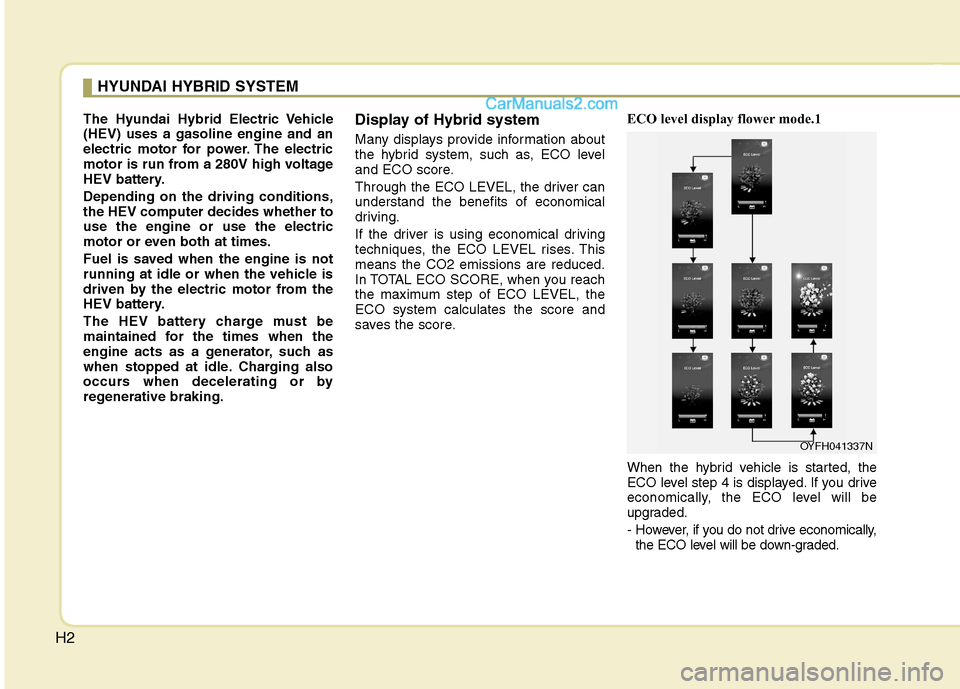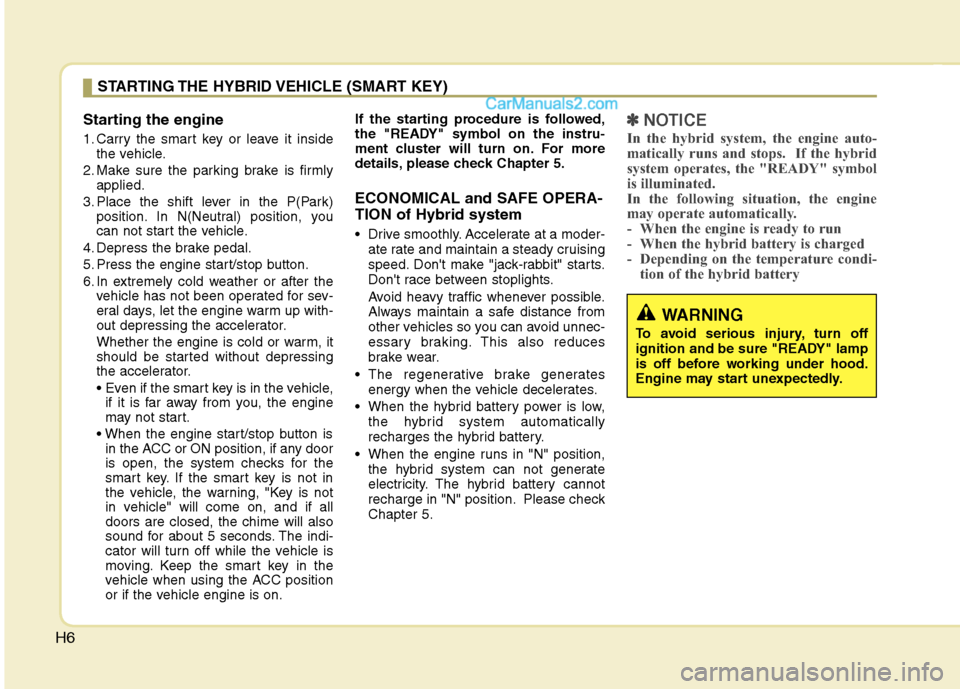Page 399 of 425
87
Specifications, Consumer information, Reporting safety defects
VEHICLE IDENTIFICATION
NUMBER (VIN)
The vehicle identification number (VIN) is
the number used in registering your car
and in all legal matters pertaining to its
ownership, etc.
The number is punched on the engine
compartment bulkhead.The VIN is also on a plate attached to the
top of the dashboard. The number on the
plate can easily be seen through the
windshield from outside.
VEHICLE CERTIFICATION
LABEL
The vehicle certification label attached
on the driver’s side center pillar contains
the vehicle identification number (VIN).
OYF089005OYFH081004NOBH088005N
Frame number (if equipped)VIN label
Page 400 of 425
Specifications, Consumer information, Reporting safety defects
8 8
TIRE SPECIFICATION AND
PRESSURE LABEL
The tires supplied on your new vehicle
are chosen to provide the best perform-
ance for normal driving.
The tire label located on the driver's side
center pillar gives the tire pressures rec-
ommended for your car.
ENGINE NUMBER
The engine number is stamped on the
engine block as shown in the drawing.
REFRIGERANT LABEL
The refrigerant label is located on the
engine compartment bulkhead.OYF089002OYFH081003NOYFH081005N
Page 404 of 425

H2
The Hyundai Hybrid Electric Vehicle
(HEV) uses a gasoline engine and an
electric motor for power. The electric
motor is run from a 280V high voltage
HEV battery.
Depending on the driving conditions,
the HEV computer decides whether to
use the engine or use the electric
motor or even both at times.
Fuel is saved when the engine is not
running at idle or when the vehicle is
driven by the electric motor from the
HEV battery.
The HEV battery charge must be
maintained for the times when the
engine acts as a generator, such as
when stopped at idle. Charging also
occurs when decelerating or by
regenerative braking.Display of Hybrid system
Many displays provide information about
the hybrid system, such as, ECO level
and ECO score.
Through the ECO LEVEL, the driver can
understand the benefits of economical
driving.
If the driver is using economical driving
techniques, the ECO LEVEL rises. This
means the CO2 emissions are reduced.
In TOTAL ECO SCORE, when you reach
the maximum step of ECO LEVEL, the
ECO system calculates the score and
saves the score.ECO level display flower mode.1
When the hybrid vehicle is started, the
ECO level step 4 is displayed. If you drive
economically, the ECO level will be
upgraded.
- However, if you do not drive economically,
the ECO level will be down-graded.
HYUNDAI HYBRID SYSTEM
OYFH041337N
Page 405 of 425
H3
ECO level display flower mode.2
In the “vehicle setting”, if you change the
animation mode to "ON", the dynamic
image will be activated.
- This provides the driver with the
dynamic ECO mode.Total ECO score display
If your ECO level achieves the top step,
your ECO score automatically saves 1
point.
In the “vehicle setting”, if you change the
animation mode to “ON”, the dynamic
image will be on.SOC Gauge (State of charge)
This State of Charge(SOC) gauge indi-
cates the remaining Hybrid battery
power. If the SOC is near L level, the
vehicle automatically operates the
engine to charge the battery. However, if
the service indicator and
MIL(Malfunction indicator lamp) turn on
when the State of Charge(SOC) is near
L(Low), the vehicle should be towed.
Refer to Chapter 6 for towing information.
OYFH041338NOYFH041339N
OYFH041311N
Page 406 of 425
H4
The Hyundai SONATA hybrid system
notifies customers of its energy flow
through MODE.
While driving, eleven MODEs show driv-
ers the current operating system.
Vehicle Stop
This mode means the
vehicle is stopped.
(No energy flow)
EV Propulsion
Motor power is used to
propel the vehicle.
(Battery ➞Wheel)
Power Assist
Motor and Engine
power are used to pro-
pel the vehicle.
(Battery & Energy ➞
Wheel)
Engine Only Propulsion
Engine power is used
to propel the vehicle.
(Engine ➞Wheel)
Engine Generation
When the vehicle is
stopped, engine charges
the high voltage battery.
(Engine ➞Battery)
SONATA HEV ENERGY FLOW
OYFH041320N
OYFH041347N
OYFH041329N
OYFH041333N
OYFH041335N
Page 407 of 425
H5
Regeneration
The high voltage battery
is charged by the regen-
erative brake system.
(Wheel ➞Battery)
Engine Brake
Engine braking is used
to help decelerate the
vehicle.
(Wheel ➞Engine)
Power Reserve
When the engine oper-
ates the vehicle, the
battery is simultane-
ously charged.
(Engine ➞ Wheel &
Battery)
Engine Generation/Motor Drive
The engine charges
the high voltage bat-
tery. The motor propels
the vehicle.
(Engine ➞Battery ➞
Wheel)
Engine Generation/Regeneration
The engine and regen-
erative brake system
charges the high volt-
age battery.
(Engine & Wheel ➞
Battery)
Engine Brake/Regeneration
To decelerate the vehi-
cle, engine braking is
used while the regener-
ative braking is applied
and also charges the
hybrid battery.
(Wheel ➞Engine &
Battery)
OYFH041336N
OYFH041333NOYFH041349N
OYFH041323N
OYFH041329N
OYFH041332N
Page 408 of 425

H6
Starting the engine
1. Carry the smart key or leave it inside
the vehicle.
2. Make sure the parking brake is firmly
applied.
3. Place the shift lever in the P(Park)
position. In N(Neutral) position, you
can not start the vehicle.
4. Depress the brake pedal.
5. Press the engine start/stop button.
6. In extremely cold weather or after the
vehicle has not been operated for sev-
eral days, let the engine warm up with-
out depressing the accelerator.
Whether the engine is cold or warm, it
should be started without depressing
the accelerator.
if it is far away from you, the engine
may not start.
in the ACC or ON position, if any door
is open, the system checks for the
smart key. If the smart key is not in
the vehicle, the warning, "Key is not
in vehicle" will come on, and if all
doors are closed, the chime will also
sound for about 5 seconds. The indi-
cator will turn off while the vehicle is
moving. Keep the smart key in the
vehicle when using the ACC position
or if the vehicle engine is on.If the starting procedure is followed,
the "READY" symbol on the instru-
ment cluster will turn on. For more
details, please check Chapter 5.
ECONOMICAL and SAFE OPERA-
TION of Hybrid system
Drive smoothly. Accelerate at a moder-
ate rate and maintain a steady cruising
speed. Don't make "jack-rabbit" starts.
Don't race between stoplights.
Avoid heavy traffic whenever possible.
Always maintain a safe distance from
other vehicles so you can avoid unnec-
essary braking. This also reduces
brake wear.
The regenerative brake generates
energy when the vehicle decelerates.
When the hybrid battery power is low,
the hybrid system automatically
recharges the hybrid battery.
When the engine runs in "N" position,
the hybrid system can not generate
electricity. The hybrid battery cannot
recharge in "N" position. Please check
Chapter 5.
✽ ✽
NOTICE
In the hybrid system, the engine auto-
matically runs and stops. If the hybrid
system operates, the "READY" symbol
is illuminated.
In the following situation, the engine
may operate automatically.
- When the engine is ready to run
- When the hybrid battery is charged
- Depending on the temperature condi-
tion of the hybrid battery
STARTING THE HYBRID VEHICLE (SMART KEY)
WARNING
To avoid serious injury, turn off
ignition and be sure "READY" lamp
is off before working under hood.
Engine may start unexpectedly.
Page 409 of 425
H7
THE COMPONENTS OF HYBRID VEHICLE
OYFH021001N-1
1. Engine : 2.4L
2. Drive Motor : 30kW
3. Transmission : 6AT
4. Hybrid Starter Generator (HSG)
5. High voltage battery system6. HPCU (Hybrid Power Control Unit)
7. Electric Water Pump (EWP)
8. Brake system with hydraulic booster
9. Electric air-conditioning compressor
10. Electric Oil Pump (EOP)